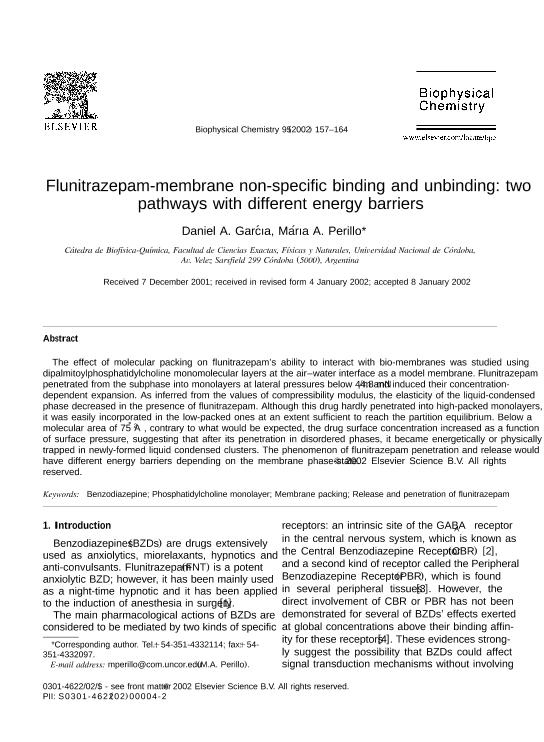Artículo
Flunitrazepam-membrane non-specific binding and unbinding: Two pathways with different energy barriers
Fecha de publicación:
19/02/2002
Editorial:
Elsevier Science
Revista:
Biophysical Chemistry
ISSN:
0301-4622
Idioma:
Inglés
Tipo de recurso:
Artículo publicado
Clasificación temática:
Resumen
The effect of molecular packing on flunitrazepam's ability to interact with bio-membranes was studied using dipalmitoylphosphatidylcholine monomolecular layers at the air-water interface as a model membrane. Flunitrazepam penetrated from the subphase into monolayers at lateral pressures below 44.8 mN/m and induced their concentration-dependent expansion. As inferred from the values of compressibility modulus, the elasticity of the liquid-condensed phase decreased in the presence of flunitrazepam. Although this drug hardly penetrated into high-packed monolayers, it was easily incorporated in the low-packed ones at an extent sufficient to reach the partition equilibrium. Below a molecular area of 75 Å2, contrary to what would be expected, the drug surface concentration increased as a function of surface pressure, suggesting that after its penetration in disordered phases, it became energetically or physically trapped in newly-formed liquid condensed clusters. The phenomenon of flunitrazepam penetration and release would have different energy barriers depending on the membrane phase-state. Copyright © 2002 Elsevier Science B.V.
Archivos asociados
Licencia
Identificadores
Colecciones
Articulos(IIBYT)
Articulos de INSTITUTO DE INVESTIGACIONES BIOLOGICAS Y TECNOLOGICAS
Articulos de INSTITUTO DE INVESTIGACIONES BIOLOGICAS Y TECNOLOGICAS
Citación
Garcia, Daniel Asmed; Perillo, Maria Angelica; Flunitrazepam-membrane non-specific binding and unbinding: Two pathways with different energy barriers; Elsevier Science; Biophysical Chemistry; 95; 2; 19-2-2002; 157-164
Compartir
Altmétricas




